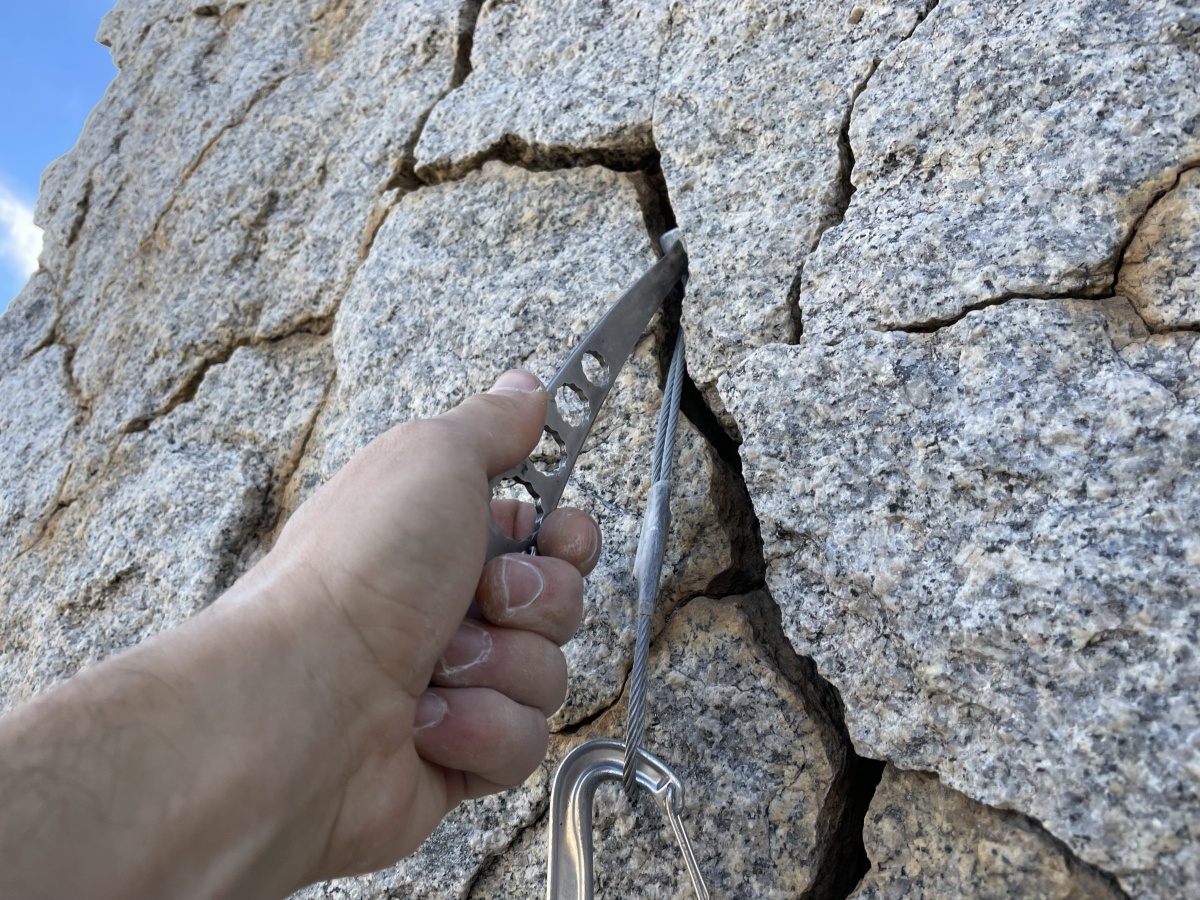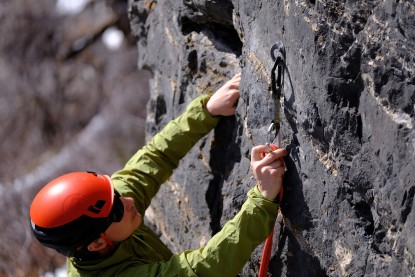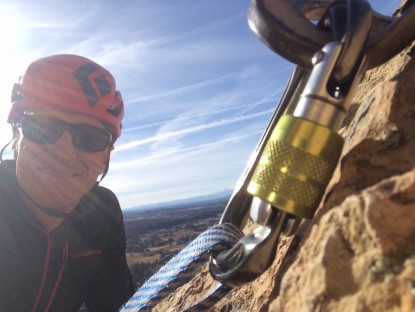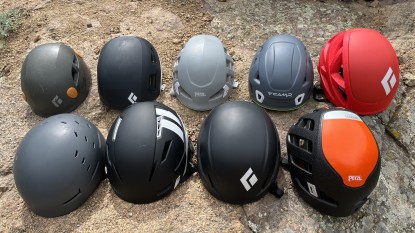The nut tool is that essential piece of gear that you'll carry up hundreds of pitches, perhaps never pulling it off your harness — but as soon as your neglect to bring it along, your partner takes fat whipper and wields your favorite brass offset into some irretrievable position, resulting in a maelstrom of cursing and bloody knuckles and ultimately a lost piece. At least it wasn't a cam. Our buying advice article is here to hammer the importance of the venerable nut tool into your thick, helmet-clad skull. These seemingly simple devices have helped us MacGyver our way in and out of trouble, served as utensils, remedied minor medical emergencies, and even solved a few automotive issues. Never underestimate the power of the mighty nut tool. After some entertaining reading, head over to The Best Nut Tools for Climbing and pick the best nut tool for your next trad climbing adventure.
What is a Nut Tool
So you've blown every dollar you earned toiling all season at the summer camp on a shiny new rack of cams and a set of nuts. You've read Wall Rats, Rock Jocks, and Hang Dogs and you're ready for long days of climbing in the mountains. Your best friend doesn't know how to lead, but he's a champion belayer and is psyched to split the gas. You arrive in Yosemite National Park, are terrified by the sheer imposing walls of El Cap, and wisely decide to learn the ways of granite smchoozery on something a little more fun-sized — Bishop's Terrace, a classic 5.8. You cruise up the perfect splitter cracks that accept perfect cam placements to a scenic ledge, build an anchor, and belay your inexperienced and eager partner on up. He climbs up to where you've placed a bomber #4 Camalot, but you didn't extend with a sling, and now it's walked slightly deeper into the crack, over-cammed, and your trusty road dog can't get it out. Enter the Nut Tool. With this slim piece of metal with a nifty hook on the end, your buddy can reach farther into the crack, pry at the cam lobes, and wiggle them until the cam is in a position where he can hook the trigger and retrieve your cam. Think of the humble nut tool as an insurance policy for your expensive cams and nuts. Nut tools are also a great way to get peanut butter out of the jar and into your mouth.
In the olden days, when Yvon Chouinard began to promote "clean climbing" (using removable nuts instead of hammering pitons), the nut tool was devised so that the second climber could bash out nuts that the leader had weighted in thin cracks. They were very simple, but they did the trick. When climbers began using cams in the late 70s, a two-pronged nut tool emerged so that climbers could hook both sides of the cam trigger and remove rigid stemmed cams that would walk back into the cracks.
Today's nut tools are very similar to the originals, but every major brand has its own unique design twists in an attempt to make this versatile little device even more useful, adding a built-in carabiner, holes for tightening bolts, or combining the nut tool with a small foldable knife.
Choosing the Right Tool For You
Our team of reviewers has gone deep inside the noble nut tool and identified the key features that differentiate these metal implements of nut retrieval from each other (and also forks and prison shanks). We've arranged a system of metrics (because we love metrics) to help you choose the right tool by perusing our charts. Weight-obsessed, detail-oriented gear freaks can go even deeper with the individual reviews of each model.
Nut Cleaning
As per their original purpose, all the tools we looked at do an adequate job of cleaning nuts. In an ideal world, the second can just grab the nut by its wire and gently maneuver it out of the placement, clip it to their harness and continue free climbing (the best style). Understandably, a leader will often give the nut a little tug to "set" it, potentially making it harder for the nut to move out on its own, and instill a little confidence while she cranks out difficult moves above. If the leader falls on the nut, she'll wedge it even harder in the crack, and the second will have to bust out the nut tool to hammer out the stuck nut and may even have to hang on the rope. (alternatively, the second could leave the nut, send the pitch, and lower down and retrieve it afterward to retrieve it, because style is important). Either way, the tool needs to come off the harness and be used to gently (or sometimes violently) bash out the stuck nut. We recommend clipping the tool to a sling connected to the rope so you won't drop it while you bash your nuts out. The Wild Country Pro Key comes with a telephone-style cord to keep you from dropping your tool to the ground.
A few of our favorite models include a "butt" — extra metal at the end so you'll have a blunter, larger surface to hammer at. We've even used Grigris and rocks in tandem with nut tools to retrieve particularly stubborn pieces.
Cam Cleaning
The subtle, sweet science of removing stuck cams comes from years of experience with different brands of cams on different types of rock. A savvy climber can free seemingly irretrievable cams just by wiggling them just the right way, but sometimes it can't be done without a trusty nut tool. All the nut tools we reviewed share a similar shape — a flat 8-inch stick with a hook at the end — that facilitates hooking a cams trigger bar, or even a hole in one of the cam's lobes. Generally, a longer nut tool is better for cleaning cams that walk deep into cracks. Some folks who see retrieving stuck gear as a sport in itself are known to carry two nut tools and some coat hangers to reach deep into cracks, hook the triggers and retrieve long-abandoned gear.
Occasionally, a little aggression is necessary to unstick your valuable camming units, and you'll need to give that cam a big bashing. Nut tools that are strong (heavier) and have a wide end for hitting comfortably with your palm are crucial for bumping a cam in a slightly wider section of crack for removal. This is easier to do in sandstone and may be impossible in granite. Be careful and use discretion. Routes on soft sandstone like the classics found in Zion National park have suffered significant damage over the years from aiding and falling on cams.
Ease of Handling
The best nut tool is the one that sits on your gear loop while you pretty much forget that it's there. You can detach it from your harness easily, free a stuck nut with one gentle poke and carry on with grace and style. In reality, nut tools can get caught on rocks and slings due to their hook shape. Take a weird fall, and the pointy end of a nut tool can stab you in the leg, believe us, we've seen it. Length, shape, and ergonomics all play into the user experience. If light and fast is your MO and you have no ambitions to become a "booty master" who climbs on nothing but the cams and nuts you retrieved, get a lightweight nut tool with its own built-in clip-in point. It will be sufficient for occasionally hammering out nuts and as an impromptu fork.
Aid climbers are generally harder on their equipment — especially nut tools since every nut placement gets weighted and might need a little extra love for removal. The nut tool becomes a swiss army knife on a big wall, serving as a pry bar, a hook for direct aid, a gardening tool, a splint, a utensil, or a cheater stick. For big walls and big adventures, you may want a nut tool with some added value. The Metolius Torque has holes for tightening bolts of three different sizes.
As mentioned previously, the Wild Country Pro Key features a keeper cord. This feature is reassuring for folks with butterfingers, though other testers worried about it becoming tangled in other carabiners racked on their harness and said they'd never climb with a "dork cord" dangling off their harness all the time. Overall, our testers preferred to climb without the keeper cord. Climbing in granite areas involves squeezing and squirming up offwidths and tight chimneys, and you don't want a cord hanging off you that can get tangled and clipped to
Durability
You're going to beat the hell out of your nuts if you are consistently trad climbing, even more so if you're new to the game. Initially, you'll be getting pieces stuck more often. Most of the tools we compared are very durable and ready to get wailed on with rocks, Grigris, or whatever you can find, but the lighter models felt like they could break or bend. For aid climbing, we suggest a tougher, heavier nut tool.
Weight
Light is right in the mountains, and if big miles and easy alpine are your jam, a featherweight tool will shave precious ounces off your kit. Just remember you'll be sacrificing durability. Here is another place where the weight savings of the nut/tool knife combo can come in handy for replacing raggedy old tat or (heaven forbid) cutting stuck or core shot ropes.
A Few Things to Supplement Your Nut Tool
Nut tools can be used for a myriad of improvised implements, but if you swaddle it in a little duct tape, your nut tool can go even farther. Tape it to a nut and slot a critical out-of-reach placement. Aid climbers wear fingerless gloves that provide a little extra palm padding. The comfort goes a long way on big wall climbs where you may be cleaning hundreds of placements.












